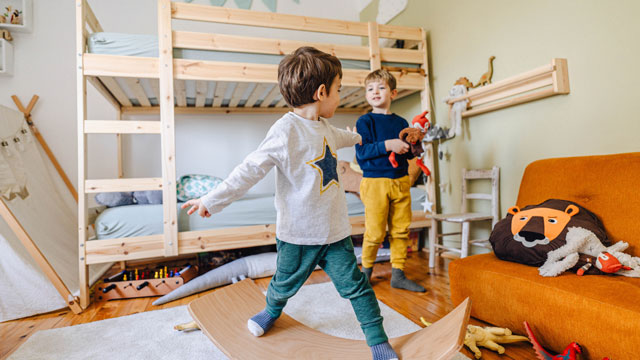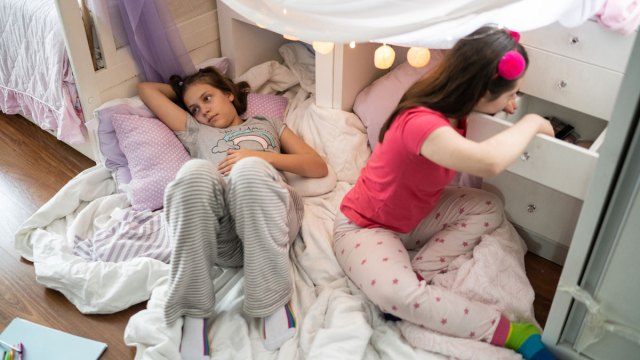We’ve even got a few tips and tricks to help you make it work
Sibling room sharing can be great, and it can be… not so great. Putting two people in a room together is always a little complicated, even when, or maybe especially when, they’re related. Whether you’re thinking about having your kids share a room because you desperately need a dedicated home office with a door or you’re expecting a second child and staying put in your two-bedroom apartment, we’ve got wisdom to share. Here’s a list of the pros and cons of siblings sharing a bedroom, complete with advice from seasoned experts.
First, a few benefits of siblings sharing a room
You’ll save money.
When siblings share a room, you can squeeze your family into a smaller space. If you’re squirreling away dollars for a down payment on a house or your budget’s tight, two kids in one bedroom make sense. Many kids–as many as seventy percent in the US alone–share a room. Two of my kids shared for a decade out of necessity in a house with three bedrooms and five people, and we found benefits in addition to practical cost savings and making the most of a small space.
A dedicated space practically guarantees a good night’s sleep.
Some families decide to have their kids share a room so they can have one room set aside for sleep and another room used as a play space. That keeps distracting toys out of the sleep space, which can be especially helpful for younger children who find the siren song of their beloved wooden trains impossible to resist.
Sibling bonding gets a boost.
Whispering and giggling after lights out, knowing your sibling is there in the big dark, shared bedtime stories–sharing a bedroom gives brothers and sisters lots of opportunities to bond. Kids create memories. As one of my sons, who shared a room with his brother for years, said, “We got to hang out all the time in our room, and we talked every night.”
“Room sharing can allow for added closeness between siblings. They often become each other’s confidants. The relationship that develops can be very positive,” says Dr. Tish Taylor, child psychologist and the author of Fostering Connections: Building Social and Emotional Health in Children and Teens.
Kids learn to compromise.
In a shared bedroom, siblings have opportunities for pillow fights with their built-in buddy—if they’re both up for it. When they’re not, a shared room gives kids extra practice navigating disagreements and conflict. They learn what to do if one person wants a pillow fight and the other wants to play UNO. Learning to compromise, understanding someone else’s point of view, and taking turns–kids need these skills as they get older, and when kids share space with siblings, they get extra practice.
Related: How to Create a Shared Bedroom for Kids No Matter the Space
Here are the trickier parts of sibling room sharing

Kids don’t have their own space.
Finding alone time is tricky when kids share a bedroom. Many older kids and tweens want to put up posters, scribble in their diaries in private, and keep their best stuff off-limits. Some families with kids in a shared bedroom find that letting kids have a say in what their side of the room looks like helps—things like picking out their bedding, hanging favorite pictures, or using a loft bed to make more private space. It’s also a good idea to make sure each child has designated storage that’s just for them, whether it’s a dresser or a closet.
Sibling conflict can be rough.
Often, especially at first, and when kids are tweens or teens, room sharing leads to more fighting, whether over room décor or just plain getting annoyed with each other. The little sister messes with her older sister’s LEGO, or a big brother takes a beloved t-shirt without permission: countless battles start over stuff. To reduce fights, establish ground rules together, or set them yourself if kids are too little to participate. Dr. Taylor suggests parents model and remind their children of their family’s core values: “You might say, ‘We love each other, and we respect each other. Even if it’s challenging and we’re in close quarters, we have to work things out respectfully.’”
Dr. Taylor also notes there may be other considerations depending on individual children. “Most children regulate really well. A small minority have challenges with that and amp up at night, which makes it difficult for the other sibling who wants to wind down, chill out, and go to sleep.” If that’s the case in your house, consider how you can give each child what they need. If one child needs extra time to settle in the bedroom, the other might go on a walk with a parent, do homework at the kitchen table, or relax on the couch with a story. Get creative, and while sibling conflict in a shared bedroom probably won’t disappear, you may be able to keep it to a minimum.
Different gender siblings.
As kids of different genders get older, they may crave more privacy. This often happens in later elementary school, at about age 10. Of course, this can also happen with kids of the same gender. Puberty is always a roller coaster. If older brothers and sisters are sharing a bedroom and space is limited, brainstorm ways to add privacy within a shared bedroom. A privacy wall, like this one with built-in storage, or a room divider can help!
Sleep disruptions will drive everyone bananas.
If a baby isn’t yet sleeping through the night, sharing a bedroom with their sibling will only make things worse. The last thing parents need is less sleep. Cara Dumaplin, a nurse and sleep expert from Taking Cara Babies, offers lots of wisdom for promoting sleep in a shared bedroom. She says, “The biggest mistake I see parents make when setting up a shared sibling room is putting little ones in the same room before they’re sleeping well.”
Luckily, there are ways around room-sharing sleep trouble. If you’re planning to have a baby and an older child share a room, wait to move the baby into the shared bedroom until your child is at least six months old and sleeping through the night. Cara also suggests staggering bedtimes, with the younger child going to bed before the older child, to support good sleep habits. Then, carefully arrange the shared room.
“Once you have two great little sleepers, you’ll want to set the room up for success. Arrange the furniture so that the crib and bed are on opposite sides of the room. Add a sound machine, ideally between the two of them. This can keep the sounds of one child from waking the other,” Dumaplin explains.
If room sharing is right for your family, don’t give up. “Expect that you may see some sleep hiccups right when your little ones move into the same room, especially around stalling at bedtime and early morning wakings. Don’t let that scare you. Be consistent, and remember that it takes time to adjust to any change. However, if you prepare your little ones, yourself, and the room ahead of time, most siblings do really well after a short adjustment period,” says Dumaplin.
Related: 7 Simple Ideas for Designing a Kids’ Room That Grows with Them











